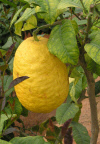ICJudaism: A Teacher’s Guide to Judaism
Hosted by ICTeachers Formerly: Mike’s Rough Guide to Judaism
Disclaimer:
The contents of these pages represent the author’s personal views, experience and
understanding.
There are bound to be some things here that some Jews would disagree
with.
Sukkot

Sukkot follows hard on the heels of Yom Kippur, after a break of only 4 days. It begins on 15th Tishri and lasts for 7 days. Sukkot is Judaism’s main harvest festival and celebrates the fruit harvest. It also recalls the 40 years that the Children of Israel spent wandering in the desert after the Exodus from Egypt. During Sukkot Jews are commanded to live in booths, sometimes still called tabernacles. This commemorates both the desert wandering and the tents in which, in earlier days, people would live during harvest time.
Each family or community will build their own temporary dwelling, or sukkah in their
garden. “Living” in it is interpreted as eating in it and the commandment is considered
fulfilled by eating “at least the size of an olive”. A sukkah must have at least
2½ walls and a roof made of cut living greenery. The roof must not be so dense that
rain cannot get through it but dense enough so that it is not more light than shadow.
At night it must be possible to see the stars from inside. It is traditional to decorate
the inside of the sukkah by hanging up fresh seasonal fruits. Many families will
keep a table in their sukkah and, weather permitting, will eat their meals in there.
A particular aspect of the service on this and the other pilgrim festival (Pesach
and Shavuot) is the singing of a sequence of prayers called Hallel. This consists
of psalms 113-
During Hallel on Sukkot, we use a special ritual object usually known as the Lulav, which represents all kinds of growing things. The Lulav is more properly known as the Arba Minim, which means 4 Species because it is made of parts of 4 different plants. It consists of a lulav, or young (unopened) shoot of a palm tree, with a branch of myrtle and a branch of willow tied to its "thick" end. The fourth species is an etrog, or citron, which is rather like a large lemon. During the recitation of Hallel (see above) the three branches and the etrog are held by the end where they are bound together and shaken so that the pointed ends of the palm leaf rustle, imitating the sound of rain. The shaking is done in turn in each of the 4 compass directions and both up and down. I always think that it must be a very ancient practice and certainly has something to do with praying for a good rainy season to come.
The four species are interpreted in various ways:
- The etrog is an edible fruit (about as edible as a lemon -
but apparently good for marmalade, according to the late Rabbi Lionel Blue). It also has a pleasing fragrance; - The myrtle has a pleasing fragrance but no edible fruit;
- The palm has an edible fruit, but no fragrance;
- The willow has no fragrance nor any edible fruit.
In their ways they represent all kinds of plants. They are also said to represent
all kinds of people -
Since they are for ritual purposes, the four species must be perfect specimens. The etrog particularly must be unblemished and complete. An etrog has a kind of stalk, known as the pittom, which can easily break off. An etrog without its pittom is considered unfit for use and over the years many beautiful etrog boxes have been made by artists and craftsmen so that etrogs may be stored safely between services.
An etrog that I saw growing at the Eden Project.
The earliest date in the Gregorian calendar that Sukkot can start is 19th September; the latest is 20th October.